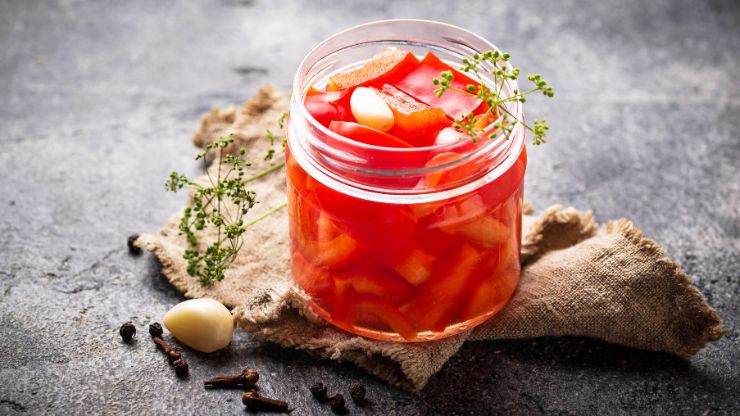If you are clearing out the end of your garden, or you just have an excess of bell peppers, you may be looking for ways to preserve them. Bell peppers can easily be chopped and frozen for cooking or roasted and pressure canned. However, if you want to fill your belly with good bacteria and preserve your peppers at the same time, I would suggest fermentation.
Fermented bell peppers have a similar texture to roasted peppers, they are soft and noodle-y, making them an excellent topping for all sorts of food. They maintain some sweetness, but they also carry that distinctive fermented tang. I find them a good introductory food for fermenting, as they are not nearly so strong tasting as a traditional sauerkraut.
Table of Contents
Toggle7 Ways to Enjoy Fermented Bell Peppers
1. Fermented Bell Pepper Relish:
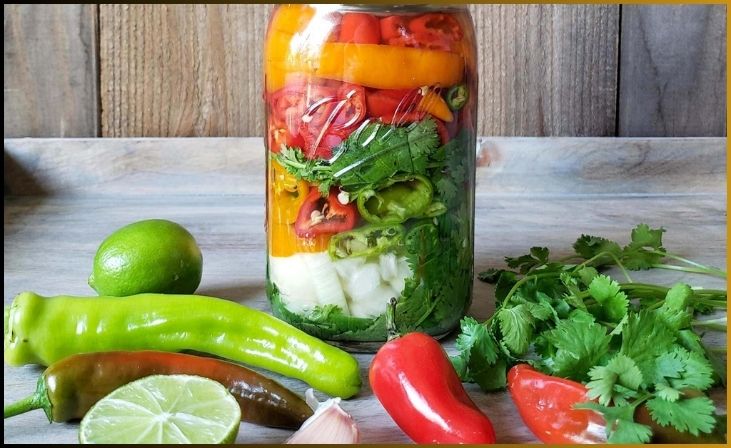
Transform your peppers into a zesty relish by combining them with onions, garlic, and a hint of chili. The fermentation process imparts a tangy kick, making it an ideal accompaniment to grilled meats, sandwiches, or as a topping for tacos. The relish not only adds a burst of flavor but also introduces a probiotic element to your meals.
For More- 4 Tips for Fermenting Fruit Successfully
Recipe: Fermented Bell Pepper Relish
Ingredients:
- Bell peppers (assorted colors), sliced
- Onion, finely chopped
- Garlic, minced
- Chili flakes
- Sea salt
Instructions:
- Mix sliced bell peppers, chopped onion, minced garlic, and chili flakes in a bowl.
- Add sea salt to taste and pack the mixture into a sterilized jar.
- Ensure the vegetables are fully submerged in their natural juices.
- Ferment for 1-2 weeks, tasting periodically for desired tanginess.
- Refrigerate and savor the relish on your favorite dishes.
2. Fermented Bell Pepper Hot Sauce:
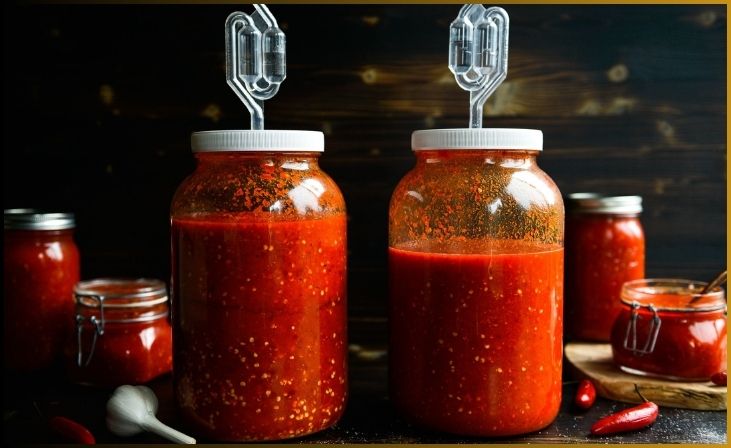
Give your hot sauce a vibrant twist by fermenting bell peppers. Combine them with fiery chili peppers, garlic, and a touch of sweetness for a condiment that packs a punch. This versatile hot sauce adds depth to marinades, dips, or any dish in need of a flavor boost.
Recipe: Fermented Bell Pepper Hot Sauce
Ingredients:
- Bell peppers (red or orange), chopped
- Chili peppers, chopped
- Garlic cloves
- Apple cider vinegar
- Honey
- Sea salt
Instructions:
- Blend bell peppers, chili peppers, garlic, and apple cider vinegar.
- Add honey and sea salt to taste, blending until smooth.
- Transfer the mixture to a jar, ensuring it’s fully submerged.
- Allow fermentation for 2-3 weeks, tasting for desired heat.
- Strain, bottle, and enjoy the homemade fermented hot sauce.
3. Fermented Bell Pepper Hummus:

Give classic hummus a twist by incorporating fermented bell peppers. The peppers add a depth of flavor and a delightful tanginess, transforming your hummus into a gourmet dip. Serve it with fresh vegetables, pita, or as a spread for sandwiches.
Recipe: Fermented Bell Pepper Hummus
Ingredients:
- Chickpeas, cooked
- Fermented bell peppers
- Tahini
- Lemon juice
- Garlic cloves
- Olive oil
- Sea salt
Instructions:
- Blend chickpeas, fermented bell peppers, tahini, lemon juice, and garlic.
- Drizzle olive oil and add sea salt to taste, blending until smooth.
- Adjust the consistency with water if needed.
- Refrigerate and serve the fermented bell pepper hummus with your favorite accompaniments.
4. Fermented Stuffed Bell Peppers:
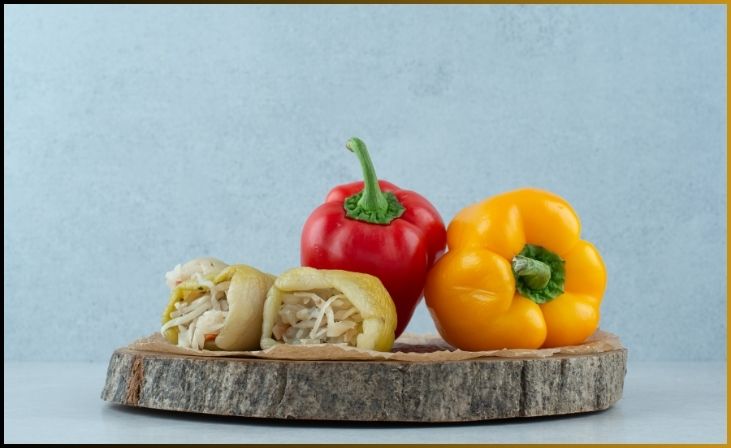
Elevate the classic stuffed pepper recipe by incorporating the depth of flavor from fermentation. Fill bell peppers with a mixture of fermented grains, vegetables, and spices, creating a dish that’s both nutritious and bursting with complex tastes.
Don't just scroll, subscribe!
BuzzTrail's unique web-stories are the cure for boredom you've been waiting for.
Recipe: Fermented Stuffed Bell Peppers
Ingredients:
- Bell peppers, halved and deseeded
- Quinoa or rice, cooked
- Fermented vegetables (carrots, cabbage, etc.)
- Onion, chopped
- Garlic, minced
- Tomato sauce
- Italian herbs
- Sea salt and black pepper
Instructions:
- Mix cooked grains, fermented vegetables, onion, and garlic.
- Fill halved bell peppers with the mixture.
- Pour tomato sauce over the peppers, seasoning with Italian herbs, salt, and pepper.
- Bake until peppers are tender, and flavors meld together.
- Serve the fermented stuffed bell peppers as a wholesome main dish.
5. Fermented Bell Pepper Salsa:
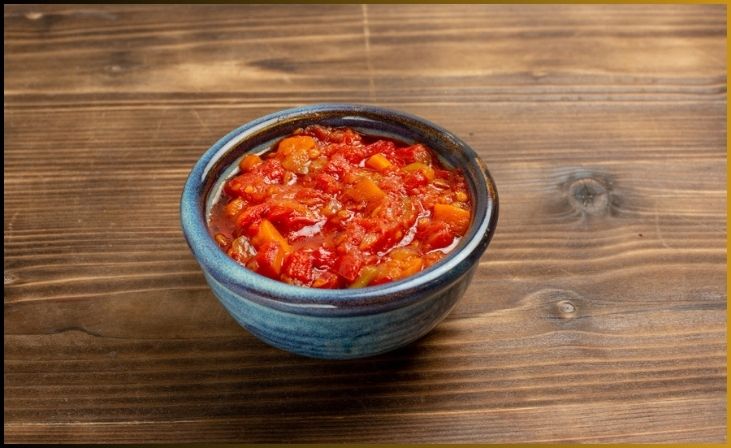
Upgrade your salsa game by introducing the complexity of fermented bell peppers. Combine them with tomatoes, onions, cilantro, and lime for a vibrant salsa that complements tacos, grilled meats, or simply scoop it up with tortilla chips.
Recipe: Fermented Bell Pepper Salsa
Ingredients:
- Bell peppers (assorted colors), diced
- Tomatoes, diced
- Onion, finely chopped
- Fresh cilantro, chopped
- Lime juice
- Jalapeño, minced (optional)
- Sea salt
Instructions:
- Mix diced bell peppers, tomatoes, onion, and cilantro in a bowl.
- Add lime juice, jalapeño (if using), and sea salt to taste.
- Pack the mixture into a jar, ensuring it’s fully submerged.
- Ferment for 1-2 weeks, adjusting salt if needed.
- Refrigerate and enjoy the vibrant flavors of fermented bell pepper salsa.
6. Fermented Bell Pepper Bruschetta:

Elevate your bruschetta game by incorporating the depth of flavor from fermented bell peppers. Mix them with fresh tomatoes, basil, and balsamic vinegar for a topping that turns simple toasted bread into a gourmet delight.
Recipe: Fermented Bell Pepper Bruschetta
Ingredients:
- Bell peppers (red or yellow), diced
- Tomatoes, diced
- Fresh basil, chopped
- Garlic, minced
- Balsamic vinegar
- Olive oil
- Sea salt and black pepper
Instructions:
- Combine diced bell peppers, tomatoes, basil, and garlic in a bowl.
- Drizzle with balsamic vinegar and olive oil, season with salt and pepper.
- Allow the mixture to marinate for at least 30 minutes.
- Spoon the fermented bell pepper bruschetta over toasted bread and savor the gourmet flavors.
7. Fermented Bell Pepper Stir-Fry:
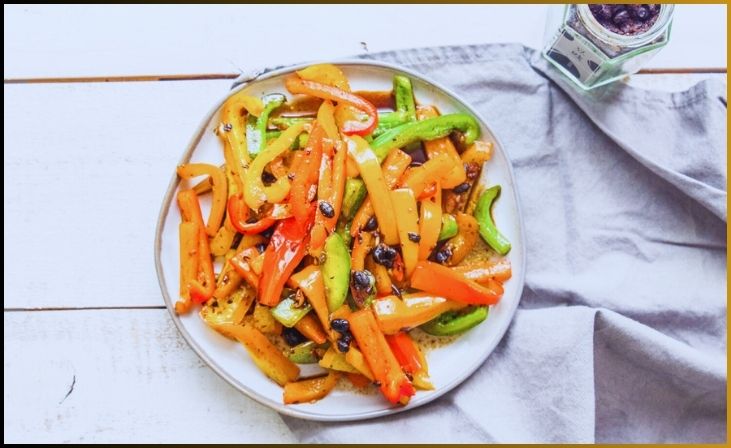
Add a twist to your stir-fry by introducing the unique taste of fermented bell peppers. Combine them with your favorite vegetables, proteins, and sauces for a quick and flavorful dish that’s sure to become a weeknight favorite.
Recipe: Fermented Bell Pepper Stir-Fry
Ingredients:
- Fermented bell peppers, sliced
- Mixed vegetables (broccoli, carrots, snap peas, etc.)
- Protein of choice (tofu, chicken, shrimp, etc.)
- Soy sauce
- Ginger, minced
- Garlic, minced
- Sesame oil
- Green onions, chopped
- Cooked rice or noodles
Instructions:
- Stir-fry protein in sesame oil until cooked.
- Add mixed vegetables, ginger, and garlic, continuing to stir-fry.
- Toss in sliced fermented bell peppers and soy sauce, cooking until vegetables are tender.
- Serve over rice or noodles, garnishing with chopped green onions.
Also Read- How to Make a Fruit Fly Trap
Conclusion
Incorporating fermented bell peppers into your culinary repertoire opens a world of flavors that extends beyond traditional uses. From vibrant relishes to zesty hot sauces, the versatility of fermented bell peppers enhances both simple and elaborate dishes. Experiment with these recipes to discover the endless possibilities of this fermented delight, transforming ordinary meals into extraordinary culinary experiences. Whether you’re a seasoned fermenter or a novice in the world of fermentation, these seven ways to enjoy fermented bell peppers promise a journey of taste exploration that will elevate your kitchen adventures.
FAQs
Can I ferment bell peppers at home?
Can I ferment bell peppers at home?
Absolutely! Fermenting bell peppers at home is a rewarding and straightforward process. Follow a reliable fermentation recipe, ensure cleanliness, and let the transformative magic of fermentation unfold.
How long does it take to ferment bell peppers?
How long does it take to ferment bell peppers?
The fermentation time for bell peppers varies but typically ranges from 1 to 3 weeks. Factors such as room temperature and desired tanginess influence the duration. Taste the peppers periodically to achieve the flavor profile you prefer.
Are fermented bell peppers safe to eat?
Are fermented bell peppers safe to eat?
Yes, when prepared and stored properly, fermented bell peppers are safe to eat. The fermentation process creates an acidic environment that inhibits harmful bacteria. Follow recommended hygiene practices and use clean utensils and containers.

